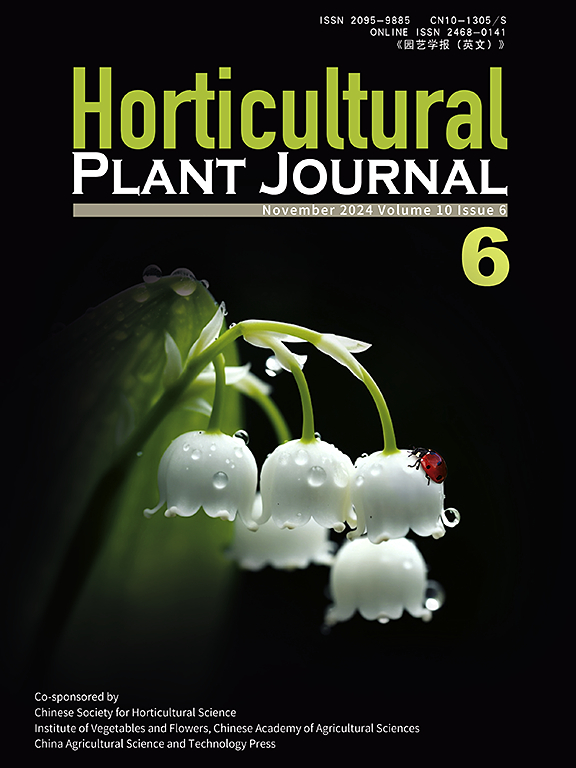RWP-RK的全基因组分析揭示了一个关键基因vnlp1.1在葡萄对硝酸盐的反应中可能发挥的作用
IF 6.2
1区 农林科学
Q1 HORTICULTURE
引用次数: 0
摘要
硝酸盐是植物的主要氮源,是调节植物发育过程的信号分子。尽管具有重要意义,但关于葡萄中硝酸盐信号的信息有限。我们利用全基因组鉴定和进化分析鉴定了分布在8条染色体上的9个VvRWP-RK基因。其中,VvNLP1-4和VvRKD1-5分别与硝酸盐信号传导和生殖生长有关。研究其潜在的功能、结构、顺式启动子元件、功能结构域、系统发育树、在不同发育阶段不同组织的时空表达水平、潜在的蛋白-蛋白相互作用网络、共效性(基因含量)、共线性(基因顺序)以及三维蛋白结构预测。研究发现,长期施用硝酸盐显著促进了葡萄植株的发育,包括初生根长度和叶片生长,并且在硝酸盐富集条件下,VvNLP1.1、VvNLP1.2和VvNLP2在“汤普森无籽”根组织中高表达。为了阐明硝酸盐在葡萄生长中的关键作用,我们观察到硝酸盐处理后,VvNLP1.1的核定位显著增加。研究发现,VvNLP1.1与硝酸盐初级应答基因VvNRT1.1的启动子结合,驱动其转录活性。这些结果表明,VvNLP1.1是葡萄硝酸盐信号通路的核心转录因子。硝酸盐分子对接分析显示,VvNLP1.1可直接与硝酸盐离子结合,表明其具有作为硝酸盐传感器直接感知硝酸盐浓度的潜在作用。我们还发现,短期硝酸盐饥饿会影响vnlp1.1启动子的活性,这与其启动子区域的脱落酸结合元件(ABRE)基序有关。本研究结果为葡萄多种生理过程,特别是硝酸盐信号通路的分子机制提供了新的认识,并为提高葡萄氮素利用效率(NUE)提供了理论依据。本文章由计算机程序翻译,如有差异,请以英文原文为准。
Genome-wide analyses of RWP–RK reveal a potential role for a key gene, VvNLP1.1, in the grapevine response to nitrate
Nitrate is the primary nitrogen source for plants and is a signaling molecule regulating various plant developmental processes. Despite its significance, limited information is available on nitrate signaling in Vitis vinifera . We identified nine VvRWP–RK genes distributed across eight chromosomes using genome–wide identification and evolutionary analyses. Among these, VvNLP1–4 and VvRKD1–5 are associated with nitrate signaling and reproductive growth, respectively. To investigate their potential functions, structures, cis –acting promoter elements, functional structural domains, phylogenetic trees, spatiotemporal expression levels in different tissues at different developmental stages, potential protein–protein interaction networks, synteny (gene content), collinearity (gene order), and three–dimensional protein structure prediction were explored. We found that long–term nitrate application dramatically promoted grapevine plantlet development, including primary root length and leaf growth, and VvNLP1.1 , VvNLP1.2 , and VvNLP2 were highly expressed in ‘Thompson Seedless' root tissues under nitrate–enriched conditions. To clarify the critical role of nitrate in grapevine growth, we observed that nuclear localization of VvNLP1.1 increased significantly following nitrate treatment. VvNLP1.1 was found to bind to the promoter of the primary nitrate response gene VvNRT1. 1, driving its transcriptional activity. These findings indicate that VvNLP1.1 is a core transcription factor of the nitrate signaling pathway in grapevine. Nitrate molecular docking analysis revealed that VvNLP1.1 directly binds to nitrate ions, indicating its potential role as a nitrate sensor capable of directly perceiving nitrate concentration. We also discovered that short–term nitrate starvation impacts VvNLP1.1 promoter activity, linked to the abscisic acid–binding element (ABRE) motif in its promoter region. Our results thus provide new insights into the molecular mechanisms underlying various physiological processes in grapevine, particularly the nitrate signaling pathway, and provide a theoretical basis for improving nitrogen use efficiency (NUE) in grapevine.
求助全文
通过发布文献求助,成功后即可免费获取论文全文。
去求助
来源期刊

Horticultural Plant Journal
Environmental Science-Ecology
CiteScore
9.60
自引率
14.00%
发文量
293
审稿时长
33 weeks
期刊介绍:
Horticultural Plant Journal (HPJ) is an OPEN ACCESS international journal. HPJ publishes research related to all horticultural plants, including fruits, vegetables, ornamental plants, tea plants, and medicinal plants, etc. The journal covers all aspects of horticultural crop sciences, including germplasm resources, genetics and breeding, tillage and cultivation, physiology and biochemistry, ecology, genomics, biotechnology, plant protection, postharvest processing, etc. Article types include Original research papers, Reviews, and Short communications.
 求助内容:
求助内容: 应助结果提醒方式:
应助结果提醒方式:


